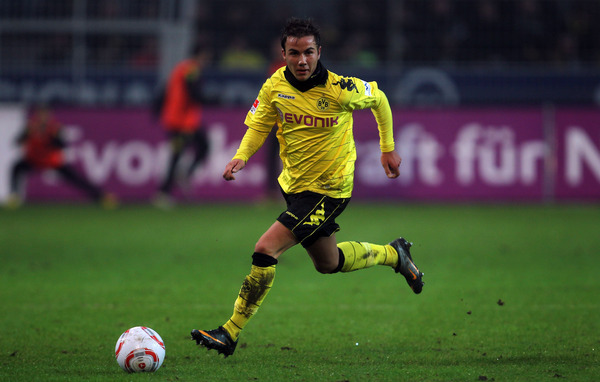It's been a roller-coaster ride for the North Rhine-Westphalia club in recent years, but this season sees them recapturing the form of the mid 1990s side. Matt Morrison finds out more.
Borussia Dortmund currently sit happily atop the Bundesliga, ten points clear of second placed Bayer Leverkusen with eleven games remaining. Not a bad position to be in having not realistically challenged for the Bundesliga title since last winning it in 2002, a period that has included a number of financial problems that led to the sale of their stadium and a 13th place finish in 2007-08.
Dortmund are not historically German heavyweights by any stretch having won just three titles since the Bundesliga’s inception in 1963, compared to Bayern Munich’s 21, but their Westfalenstadion (or ‘Signal Iduna Park’ as it is until 2016 due to a necessary sponsorship deal) holds over 80,000 and their average attendance for home matches this season is the second highest in Europe – only Barcelona can boast more by a few hundred. The south terrace, Die Südtribüne, is a sight to behold with up to 25,000 home fans gathering on its steps on alternate weekends to produce a sea of yellow and black.
 |
| Die Südtribüne, Westfalenstadion |
I’ll forever associate Borussia Dortmund with Ottmar Hitzfeld’s great fluorescent yellow shirted team of the mid-1990s that won two Bundesliga titles in 1995 and 1996 and the European Cup in 1997. Led by legendary captain and sweeper Matthias Sammer, they were the archetypal German machine for a time with the likes of Jürgen Kohler , Stefan Reuter, Andreas Möller and Karl-Heinz Riedle providing the support. Paulo Sousa and Paul Lambert provided some Portuguese flair and Scottish steel respectively for their European Cup winning season, as Lambert became one of only two Scottish players to win the European Cup in the last 27 years (Darren Fletcher, since you ask). Lars Ricken’s goal in the final versus Juventus was the stuff of playground dreams as he came off the bench to chip Angelo Peruzzi with his first touch. That made it 3-1 to Dortmund and the trophy was theirs for the first and only time.
Sammer is the last ball playing sweeper I can remember, a now near extinct position that the game is poorer without. Equally as comfortable in midfield, his runs from deep and cool head in front of goal also meant he chipped in with plenty of goals along the way. His career was cut short by a serious knee injury at the age of just 30 but not before he had won European Footballer of the Year following Germany’s success at Euro 96. Möller, generally only remembered in England for scoring the winning penalty against England in the semi final of Euro 96, was a great goalscoring midfielder, Kohler’s 105 caps for Germany were a testament to his quality and Riedle and Swiss striker Stéphane Chapuisat caused problems for the tightest defences in Europe.
"Manager Jürgen Klopp has put faith in his young players and it is paying dividends."
But gone are the days of Sammer, Möller, Riedle and Chapuisat, as Dortmund have endured a turbulent time in recent years. Despite their title win in 2002, floatation on the stock market in 2000 and some questionable financial management have led to a number of seasons in which Dortmund have been off the pace both domestically and in Europe and have often been forced to sell some of their prized assets, such as Torsten Frings to Bayern Munich in 2004 and Tomas Rosicky to Arsenal in 2006. Though there have been threats of an improvement with top six finishes in 2009 and 2010.
Dortmund’s current table topping side is far from awash with star names. In fact a passing glimpse down the squad list shows few recognisable names, Mohamed Zidan perhaps being the most internationally renowned if only for his name’s similarity with a certain headbutting Frenchman. Manager Jürgen Klopp has put faith in his young players and it is paying dividends. Their ascent to the top has been on the back of a superb away run, winning their first eight away league matches and having taken 31 out of 36 points on the road.
Japanese midfielder Shinji Kagawa hit the ground running after his €350,000 summer move from Cerezo Osaka with a number of important goals and Paraguayan striker Lucas Barrios has continued his fine goalscoring form from 2009-10. Their efforts to bring through homegrown players are being recognised at international level with the excellently named 21-year-old midfielder Sven Bender recently earning his first call up to the German squad and 18-year-old Mario Götze already gaining two caps. Centre back Mats Hummels and winger Kevin Großkreutz (both 22) have also been capped in recent months. Playmaker (and one for the teenage girls) Götze is perhaps the jewel in the crown of this Dortmund side and they will do well to hold onto him for the next few seasons – Manchester United have already been sniffing around and have been linked with a summer move in a bid to rejuvenate their creativity-starved central midfield.
 |
| Mario Götze: United bound? |
Dortmund’s worry may be that their youth and lack of experience of winning titles will affect them during the run-in, but ten points is some cushion. Their lack of fear could also see them through without trouble as they are showing no sign of faltering. A big game awaits them at the Allianz Arena on Saturday against third placed Bayern Munich and a win would be a massive step toward a fourth Bundesliga title for the team from Nordrhein-Westfalen.
No comments:
Post a Comment